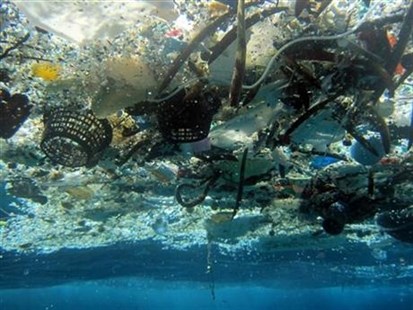
This 2008 photo provided by NOAA Pacific Islands Fisheries Science Center shows debris in Hanauma Bay, Hawaii. A study released by the Proceedings of the National Academy of Sciences on Monday, June 30, 2014, estimated the total amount of floating plastic debris in open ocean at 7,000 to 35,000 tons. The results of the study showed fewer very small pieces than expected.
Image Credit: AP Photo/NOAA Pacific Islands Fisheries Science Center
July 01, 2014 - 4:25 PM
NEW YORK, N.Y. - Plastic junk is floating widely on the world's oceans, but there's less of it than expected, a study says.
Such ocean pollution has drawn attention in recent years because of its potential harm to fish and other wildlife.
The new work drew on results from an around-the-world cruise by a research ship that towed a mesh net at 141 sites, as well as other studies. Researchers estimated the total amount of floating plastic debris in open ocean at 7,000 to 35,000 tons.
Andres Cozar of the University of Cadiz in Spain, an author of the study, said that's a lot less than the 1 million tons he had extrapolated from data reaching back to the 1970s.
The new estimate includes only floating debris, not plastic that may reside beneath the surface or on the ocean floor.
Some floating pieces start out small, like the microbeads found in some toothpastes and cosmetics or industrial pellets used to make plastic products. Other small pieces can result when wave action breaks up larger objects, like bottle caps, detergent bottles and shopping bags.
The net turned up fewer small pieces than expected, and it will be important to figure out why, researchers said. Perhaps the tiniest pieces are being eaten by small fish, with uncertain effects on their health, Cozar said in an email.
While the research showed plastic to be distributed widely, concentrations were highest in five areas that were predicted by ocean current patterns. They are west of the U.S., between the U.S. and Africa, west of southern South America and east and west of the southern tip of Africa.
Plastic debris from land reaches the ocean mostly through storm water runoff, the researchers said in their report, released Monday by the Proceedings of the National Academy of Sciences.
Kara Lavender Law, who studies plastic pollution at the Sea Education Association in Massachusetts, said the study provides the first global estimate she knows of for floating plastic debris.
"We are putting, certainly by any estimate, a large amount of a synthetic material into a natural environment," said Law, who didn't participate in the new work. "We're fundamentally changing the composition of the ocean."
The impact on fish and birds is hard to gauge because scientists don't understand things like how much plastic animals encounter and how they might be harmed if they swallow it, she said.
___
Online:
Journal: http://www.pnas.org
Federal information: http://marinedebris.noaa.gov/info/plastic.html
Sea Education Association plastics project: http://www.sea.edu/plastics
News from © The Associated Press, 2014